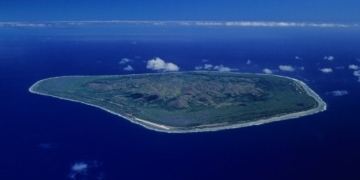As 2005 draws to a close, it leaves behind numerous significant scientific events both domestically and internationally, such as Vietnam mastering the most advanced microscopy technology, efforts to develop avian influenza vaccines, the world decoding the rice genome, and more.
1. Scanning Probe Microscopy
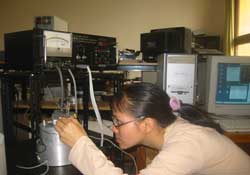 |
|
A staff member at the Institute of Applied Physics and Scientific Equipment is placing a specimen into a scanning probe microscope. |
After two years of research, scientists from the Institute of Applied Physics and Scientific Equipment (Vietnam National Science and Technology) successfully developed a scanning probe microscope (SPM). This is the most advanced experimental device globally, first manufactured in Vietnam, at a cost only a fraction of similar imported devices. The microscope has many applications, particularly in nanotechnology and molecular biology.
Having mastered the technology for manufacturing SPMs, the Institute is now capable of producing affordable scanning probe microscopes for various users, including students. Professor and Academician Vu Dinh Cu, Chairman of the State Acceptance Council, commented: “If experts were only motivated by money, they wouldn’t meticulously create such sophisticated machines. This is a 21st-century device and a remarkable success in Vietnam’s scientific and technological landscape.”
2. Carbon Composite: A Bone Substitute
The skull bone fragment made from carbon composite is the result of nearly ten years of research by experts from the Institute of Applied Technology (Ministry of Science and Technology). Thanks to this fragment, doctors can seal skull defects without needing to perform surgery to harvest autologous bone, thereby reducing patient pain.
The material used for the fragment is biocompatible with the human body, meaning it has durability, porosity, thermal conductivity, and thickness similar to that of skull bone. The advantage of carbon composite fragments over other materials is their low cost, being 40 times cheaper than flat titanium patches imported from the USA and Germany, thus providing low-cost treatment opportunities for impoverished patients.
 |
|
Scientists are injecting the H5N1 vaccine into monkeys on Reu Island, Quang Ninh. |
3. Development of the H5N1 Vaccine
In response to the threat of an avian influenza pandemic, the National Institute of Hygiene and Epidemiology (NIHE) embarked on research to produce the H5N1 vaccine using cell culture methods. This vaccine has been tested on animals and is currently awaiting approval for human trials. To date, Vietnam has successfully produced six batches of H5N1 vaccine for humans. Samples from these six experimental batches have been rigorously tested according to the minimum requirements of the World Health Organization (WHO) and sent to WHO laboratories for validation.
4. Gene Technology Applications to Identify Fallen Soldiers
Since 2003, the Institute of Biotechnology (Vietnam National Science and Technology) has identified 60 cases, of which 36 fallen soldiers have been named. To date, the entire technique for identifying the remains of fallen soldiers has been perfected by the Institute. They are now transferring technology and training staff from the Military Forensic Institute to conduct their own identifications. This success opens up prospects for identifying around 300,000 fallen soldiers whose graves still bear the inscription “Unknown Soldier,” located in nearly 3,000 cemeteries across Vietnam.
5. Prime Minister Meets with Scientists
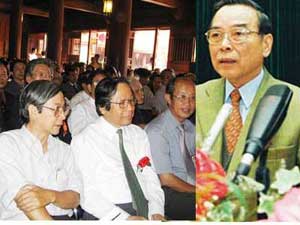 More than 400 scientists and representatives of the domestic scientific community candidly expressed their concerns regarding scientific and technological activities to Prime Minister Phan Van Khai on September 24.
More than 400 scientists and representatives of the domestic scientific community candidly expressed their concerns regarding scientific and technological activities to Prime Minister Phan Van Khai on September 24.
In addition to professional qualifications and the spirit of the working community, one reason that the state of science and technology in Vietnam currently resembles the pre-reform agricultural sector is due to the many inadequacies in the management of science and technology in Vietnam. These include insufficient income, lack of motivation to work; wasteful investments and usage, lack of proper incentives and evaluations…
To address these issues, scientists and managers recommend that the organizational system of science and technology in Vietnam should focus on financial resources while decentralizing administrative power. The state needs to primarily care for forced development, setting specific requirements for the application of science and technology as a key to changing the technological status of the country. Other application issues should be regulated by the market, with the state only partially supporting funding.
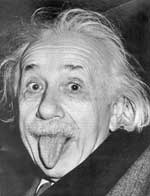 6. 2005 – The Year of Physics, The Year of Einstein
6. 2005 – The Year of Physics, The Year of Einstein
To commemorate the 100th anniversary of Einstein’s theory of relativity, the UN declared 2005 as the International Year of Physics. The goal was to promote the field of physics, attracting and encouraging young people and the public to engage with physics. The year 2005, the year of physics and Einstein, is coming to a close. A series of articles, thousands of cultural activities throughout the year celebrated a genius worldwide. Yet, the brilliance of these extraordinary ideas will forever remain youthful. The name of the man who birthed them, the greatest scientist of the 20th century, Albert Einstein (1879-1955), continues to shine brightly in human history.
7. Nobel Prizes in Medicine, Physics, and Chemistry
The Nobel Prizes in these three fields were announced in early October 2005, with the award ceremony held in Sweden. The 2005 Nobel Prize in Medicine honored two Australian scientists who discovered the Helicobacter pylori bacteria and their role in digestive system diseases.
The Nobel Prize in Physics was awarded to two American citizens – Roy Glauber and John Hall – and German scientist Theodor Haensch. These three scientists made significant contributions to advancing the application of modern quantum physics in optics and light research.
The Nobel Prize in Chemistry honored Yves Chauvin (France), Robert Grubbs, and Richard Schrock (USA), who developed the metathesis method in organic synthesis. This method opens new avenues for creating smarter drugs and more environmentally friendly plastics.
8. Gene Decoding
2005 was a remarkable year for gene decoding. After seven years, the International Rice Genome Project completed the sequencing of the rice genome, a crop that sustains over 50% of the world’s population. It is estimated that rice contains 37,544 genes across 12 chromosomes compared to 20,000-25,000 genes in humans. Decoding the rice genome is significant as it will help produce high-yield, nutrient-rich rice varieties that are more resistant to pests and diseases and can withstand harsh weather conditions.
Not stopping there, scientists also decoded the DNA of the chimpanzee, our closest living relatives.
9. Impact on Comet Tempel 1
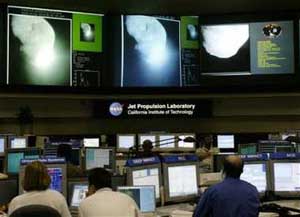 |
|
NASA’s control room displaying large screens during the impact event. |
One day, humanity will have to deal with an asteroid or comet hurtling toward Earth. In the worst-case scenario, they could annihilate civilization or at least devastate a city. Major impacts have occurred in the past and will continue to happen. However, we still know little about asteroids and their structures to plan for deflection or destruction.
A significant turning point occurred when NASA’s Deep Impact spacecraft launched a copper projectile into comet Tempel 1 on July 4. With the collected data, scientists will gain a better understanding of the nature and structure of comets as well as the formation of the solar system. Furthermore, knowing the structure of comets will aid humanity in deflecting them in the future. Another benefit is that by studying the components of comets, humanity could potentially use them in the future as water sources or refueling stations for space exploration missions.
10. China Launches Shenzhou 6
On the morning of October 12, the Shenzhou 6 spacecraft carried two Chinese astronauts into Earth orbit. This marks the second time the country has launched a manned spacecraft, making it the third nation after Russia and the USA to achieve this feat. Wang Yung-Chi, chief engineer of China’s manned space program, remarked: “Manned space flights demonstrate a nation’s economic strength and scientific research capabilities. This is a significant means to expand human living space and to explore and utilize space resources.”


















































